Our ORgan
In the original 1846 church building, Saint Paul's Church placed an organ built by noted New York CIty organ builder Henry Erben. An early photo of the church shows the organ, opposite the confessional.
The church purchased a new, larger organ from the Steer & Turner company in Westfield, Massachusetts. Initially, it was in its own freestanding case. In the photo, you can see the space where the Erben organ had been. The Erben organ, meanwhile, was either sold or given to Saint Peter's Catholic Church (essentially across the street). The historic photos were scanned from the church's photos back in 1976 by Jane and Bill Snyder. (Jane was organist at Saint Peter's at the time.) Sometime between 1884 and 1888, the organ was sold to Saint Patrick's Church in Lagro, Indiana for $700. It remains there to this day, and was restored to playable condition by Halbert Gober, longtime curator of organs at Oberlin Conservatory. Here is the Organ Historical Society page on the organ as it stands in Saint Patrick's. Saint Patrick’s is now an "oratory," no longer functioning as a regular parish. It is affiliated with Saint Bernard's Catholic Church in nearby Wabash. https://pipeorgandatabase.org/organ/4718
When the present (1897) church was built. The organ was moved into the chamber South of the chancel, where it remains today. [I have not found any record of who carried out that move.] The key action of the organ is mechanical, involving wood rods or "trackers" connecting the keys to the wind chests. (See photos) (The Erben organ is also a tracker action.) The organ was still at its original size (14 stops). there was simply grille cloth covering an opening into the transept at that time. (see photo)
The organ was showing its age over time, naturally, and was in need of restoration. In 1978, organ builder Ronald Wahl, of Appleton, Wisconsin was hired to undertake major work on the organ. Wahl made a point of restoring the instrument, keeping the original pipes and character of the organ, while cleverly making a few additions.(The picture "view from behind music rack" shows the tracker key action.) The project included adding three stops to the Pedal division (originally, there was only one), on a new wind/action chest. That new chest is situated right behind the transept altar. The pipes that make up the façade are the Violoncello stop in the Pedal.
We have also recorded two in depth organ tours: an introduction & inside tour (above) and a stops demonstration (below).
Organ Performances
Original Church Chancel with Erben
Saint Paul’s Facade Before Wahl
View from behind music rack
Saint Paul’s Facade Corner
Here is the present specification of the organ:
Steer & Turner, Opus 45, 1872
Ronald Wahl, 1978 - Additions*
24 ranks of pipes
1,223 total pipes
__________________________________________________________________
GREAT (lower keyboard) pipes <u>COUPLERS</u>
8 ft. Open Diapason 58 Swell to Pedale (drawknob)
8 ft. Dulciana 46 Great to Pedale (drawknob)
8 ft. Melodia 46
8 ft. Stop'd Diap. Bass 12 Swell to Great ON/OFF (mech. f.p.)
4 ft. Principal 58
4 ft. Flute a Chiminee 58
2 ft. Fifteenth 58 <u>TRUNDLES (Unlabeled; l - r)</u>
Mixture 2 and 4 Ranks + 232 * Piano -
Cornet 1 and 2 Ranks + 107 *
8 ft. Trumpet 58 * Forte -
SWELL (upper keyboard) pipes
8 ft. Open Diapason 46 <u>PEDAL MOVEMENTS</u>
8 ft. Keraulophon 46 Swell Expression (bal.)
8 ft. Stop'd Diapason 46
8 ft. Stop'd Diap. Bass 12
4 ft. Wald Flute (harmonic) 58
2 ft. Flautino 58 *
1-1/3 ft. Nineteenth 58 *
8 ft. Oboe 46
8 ft. Basson 12
Tremolo
PEDALE (CC-d) pipes
16 ft. Bourdon 27
8 ft. Violoncello 27 *
4 ft. Gemshorn 27 *
16 ft. Cremona 27 *
Tremolo
Swell to Pedal Coupler
Great to Pedal Coupler
Swell to Great coupler (pushbuttons under the Swell manual)
The expression pedal operates the expression shutters for the Swell division.
There are two foot treadles: One (piano) reduces the stops in the Great to three soft ones.
The second (forte) draws most of the stops on the Great.
Prepared by John Gouwens, Organist & Choirmaster







